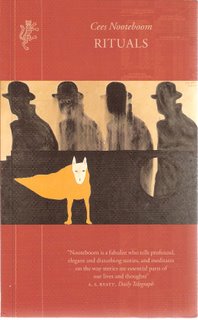 Review: Rituals, Cees Nooteboom (1983)
Review: Rituals, Cees Nooteboom (1983)This book resembles a piece of classical music. It has a symmetry that is pleasing to our senses and variations that are pleasing to our minds. In three movements of varying tempos and timbres we are introduced to a world where people commit acts of faith. But it is a secular faith, one that is devoid of mystical or supernatural elements. The rituals may be as simple as being polite (when young) to your elders, or as complex as suicide.
The opening scherzo is, naturally, brisk and comical. Here, Inni (short for Inigo, after the famous, seventeenth-century English architect) steps into the spotlight. He’s a bit of a dreamer, not overly intelligent, but deeply curious about life. It is 1963. Inni’s foil in this movement is Zita, a young, red-haired chick who has an abortion that she never gets over, completely.
In the middle passage, allegro, we are transported back to 1953. Inni, in his twenties, is introduced by an aunt to Arnold Taads, a misanthrope with a dog who sticks to a rigid timetable. He takes Inni under his wing, organises for Aunt Therese to endow a portion of capital on him. She inducts him into her household and her Catholic religion. There, he meets the joyously sexualised Petra, who fellates him and then sticks out her tongue to show him his semen on its pink surface. Another ritualised act is consummated.
Finally, in the andante we shoot forward to Inni’s early middle age. It is 1973. At 40, Inni is much wiser, more worldly. And he is as keen as ever on the chicks. Still economically independent, he roams the streets of Amsterdam scuffing up experiences. By chance, one day, outside an oriental antiques shop, he bumps into the son of Arnold Taads, Philip Taads — whose mother was, I assume, Indonesian. Philip, following in his father’s footsteps, is a misanthrope.
But there’s a difference. Where Arnold delved into modern philosophy for his spiritual sustenance, Philip dabbles with Eastern mysticism. And being of the generation of highly individualistic souls, he eschews friends for Japanese ceramics. Inni can barely stand him, but is compelled on several occasions to visit his small, walk-up apartment.
At 153 pages, this little book is perfect for an afternoon on the couch, and can be read in one swallow. Highly recommended.
No comments:
Post a Comment